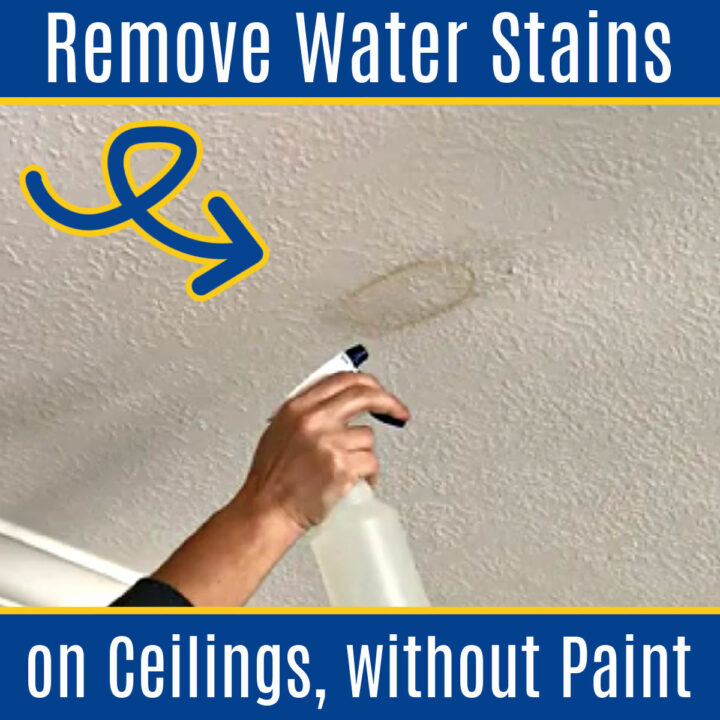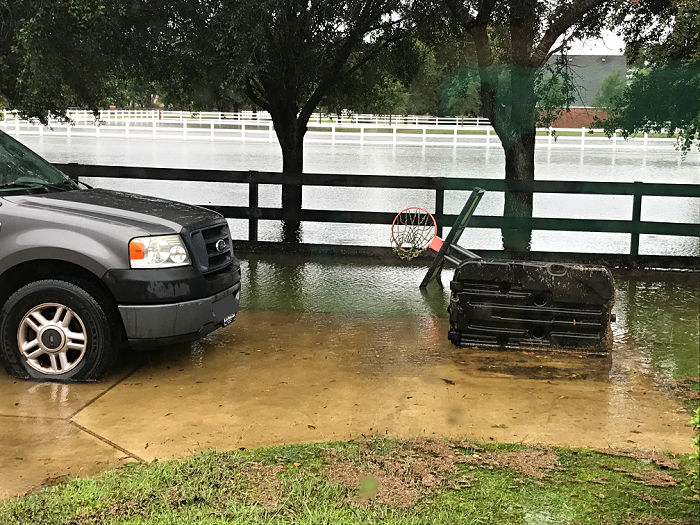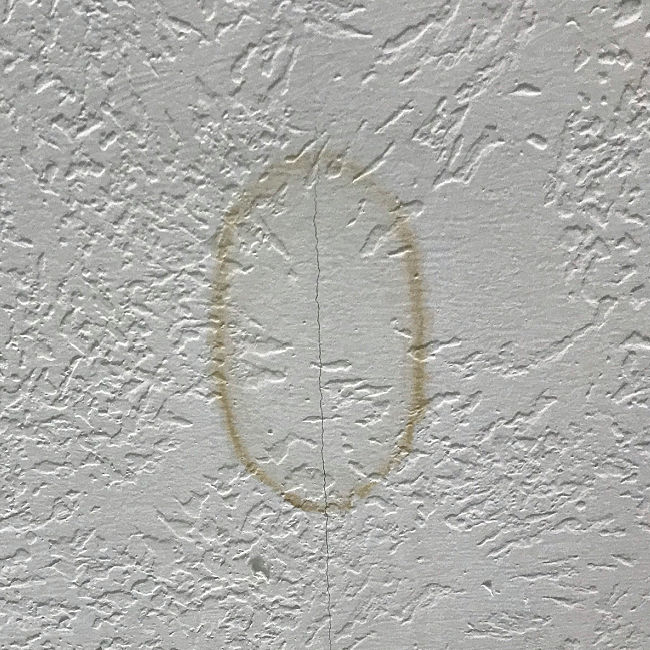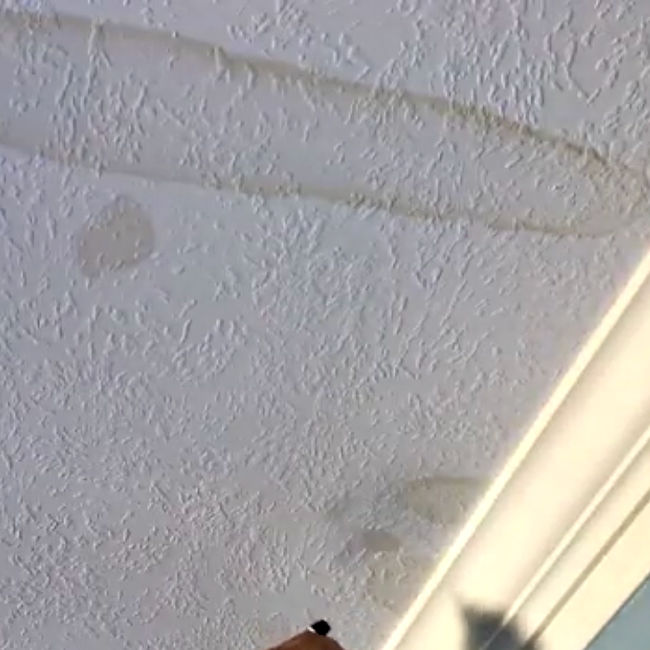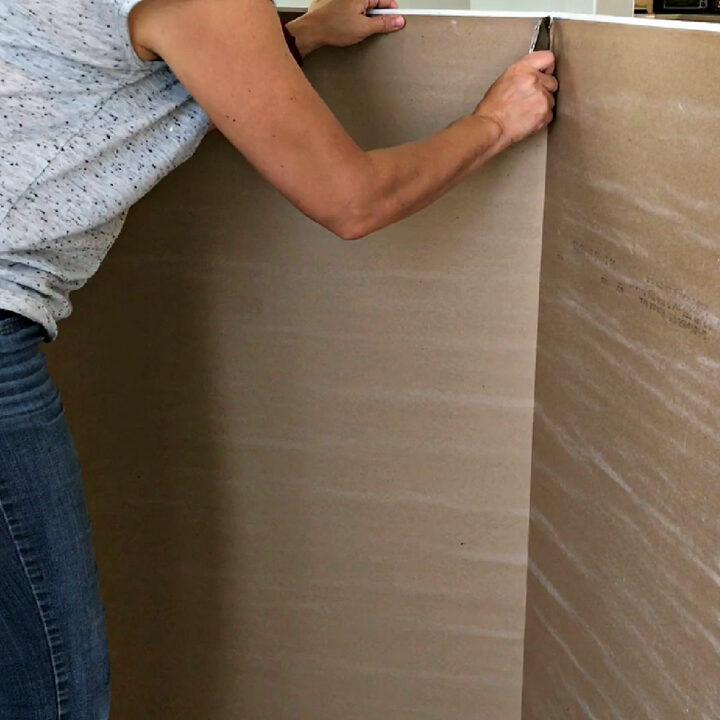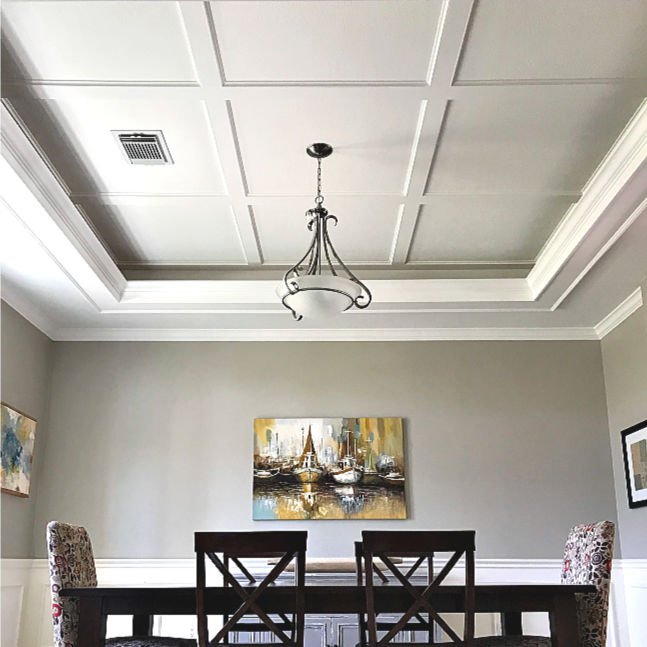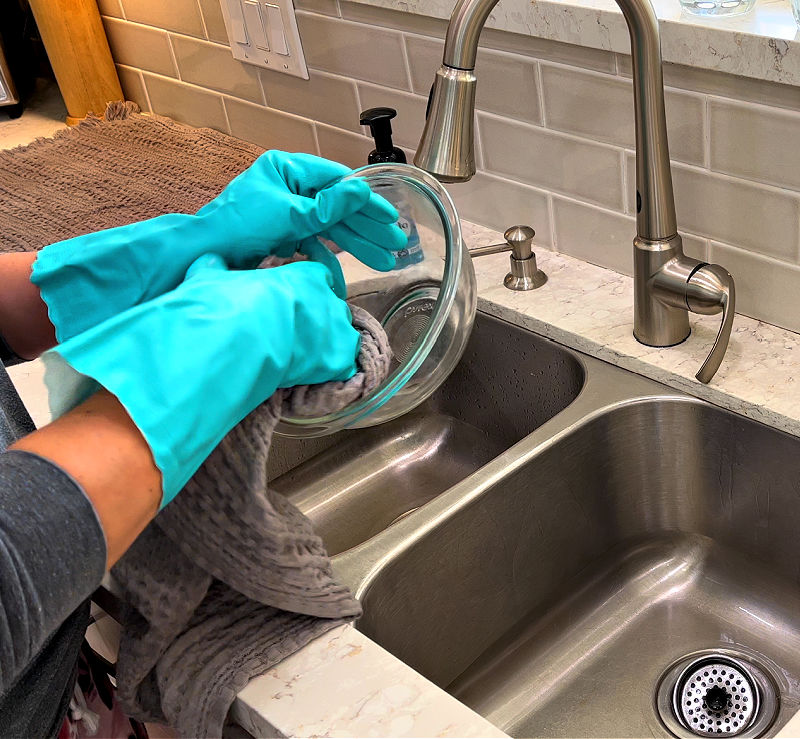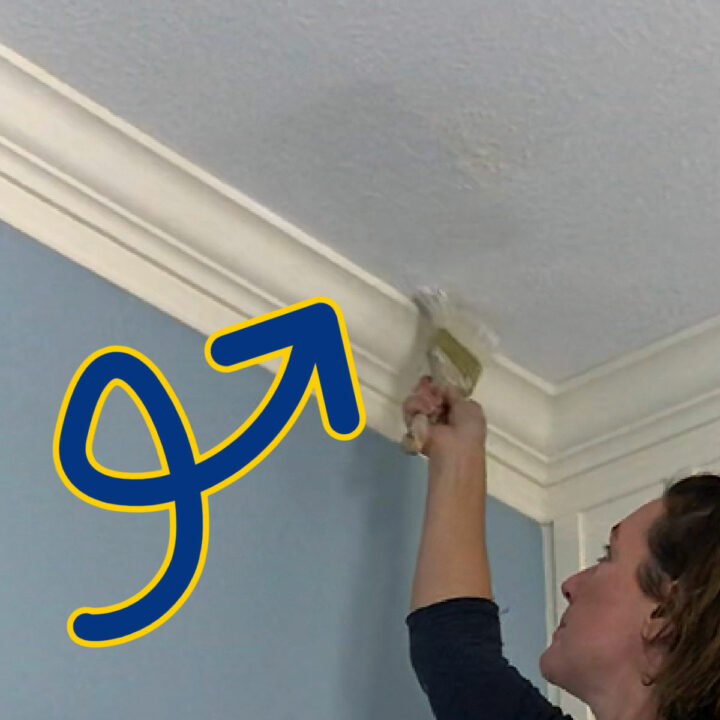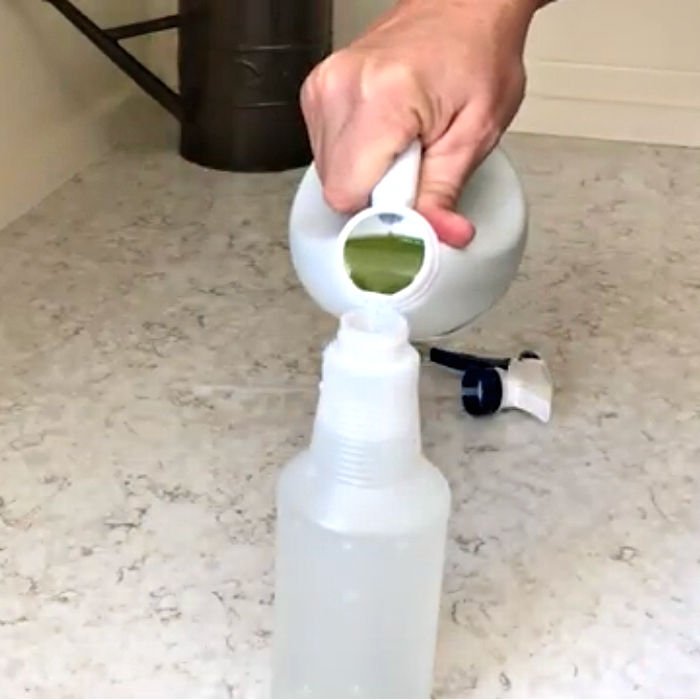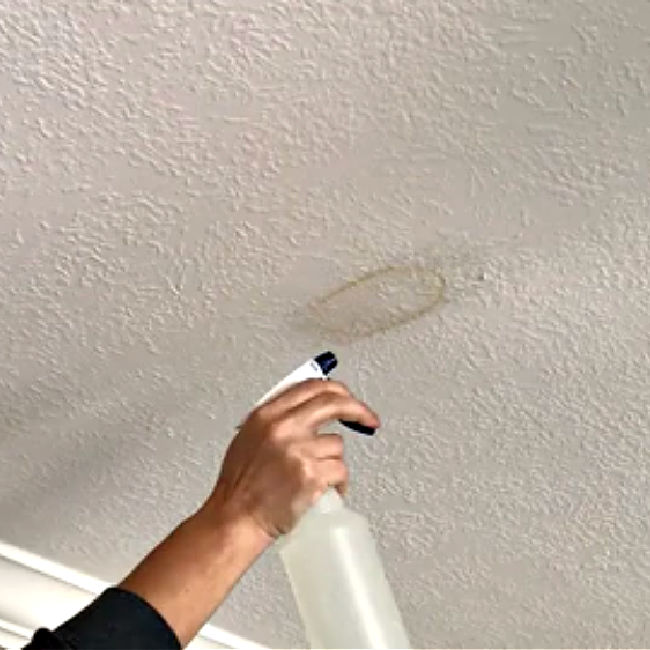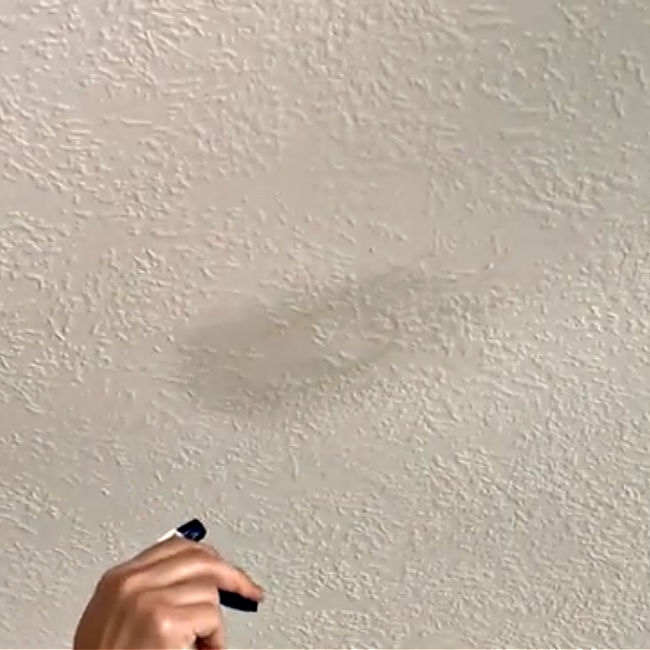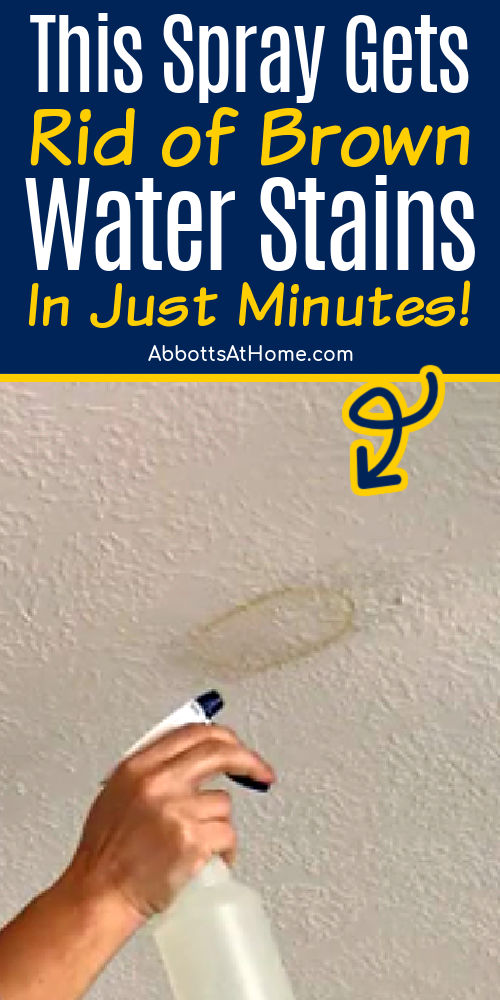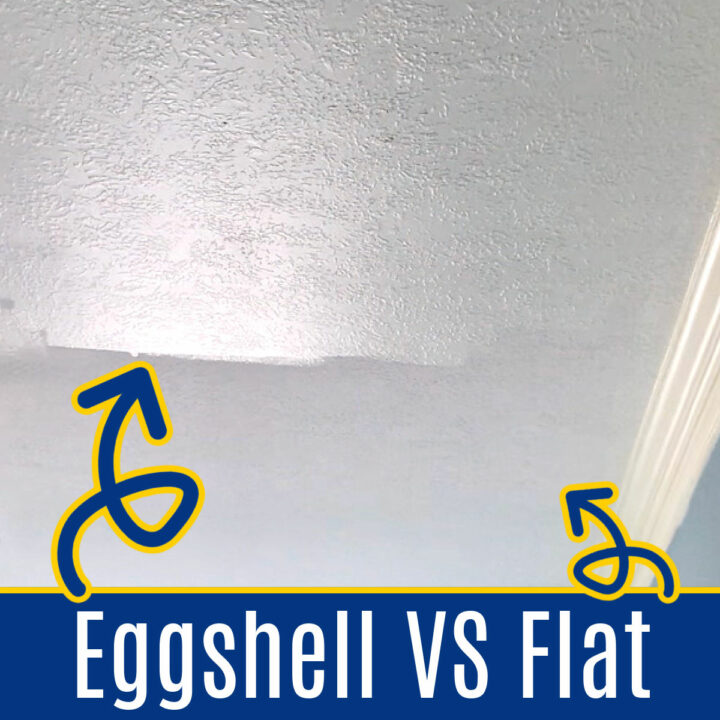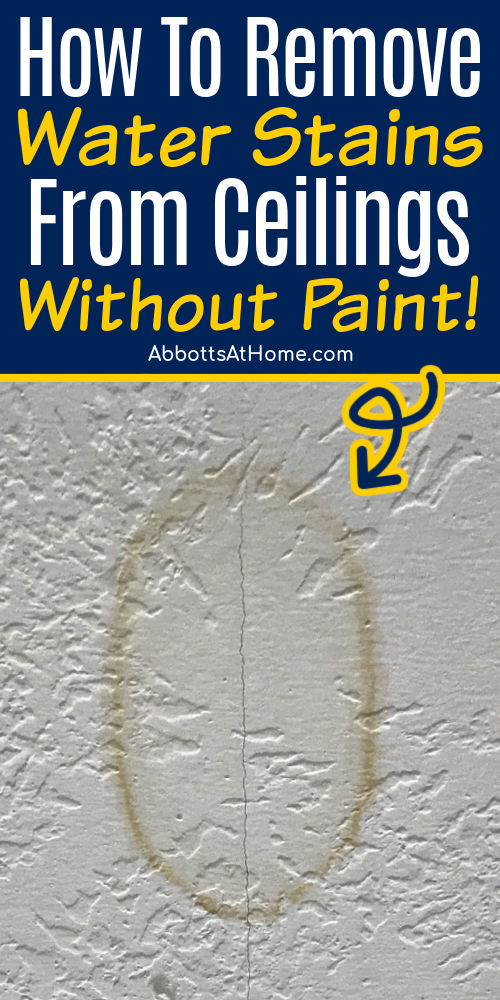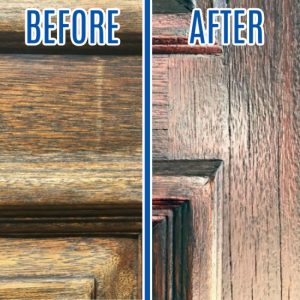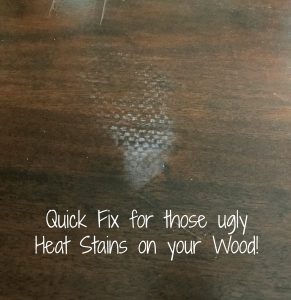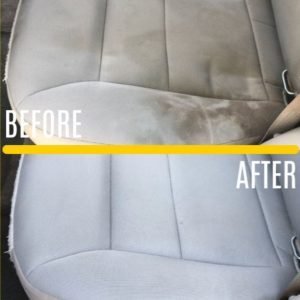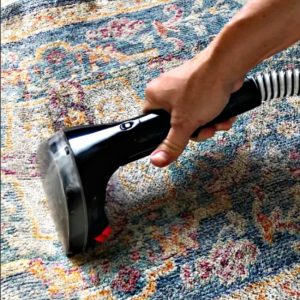Covering water stains with paint can be a time-consuming, expensive job. And, If you try to just paint over the water stain with a paint color that doesn’t match, it won’t look as bad as that brown water stain.
But it won’t look great either! So, unless you know the original paint color used on the ceiling, you’ll have to paint the whole ceiling to make that stain really disappear.
Luckily, there is a much easier way to get rid of those brown water stains on ceilings. Even with old water stains that have been there for years and years.
A mixture of bleach and water applied carefully can remove water spots on a ceiling, leaving the ceiling looking like you never had a water leak at all.
Just be sure to follow the steps below to safely and easily remove 95% of water damage and water spots on ceiling and walls.
And, just in case you’re wondering, this fix for water stains on drywall works on walls and ceilings. Though, you’ll most commonly have them on a ceiling.
Alright, let’s get to How to Remove A Water Stain On Ceilings Without Paint.
Table of contents
How to Remove Water Stain from Ceiling Without Paint – Video
If any of the steps below for How to Get Rid of Water Stains with Bleach are confusing, I highly recommend watching this short video. Hopefully seeing it done can help clear up any confusion.
This video has nearly 1 Million views on YouTube and 12,000 likes. It can be very helpful.
How Do You Get Rid of Old Water Stains on the Ceiling
It’s easy to get rid of brown water stains on ceilings and walls with a quick and easy bleach and water mix. BUT FIRST, you’ll need to answer a few questions and prep the area that needs to be repaired.
Has the Cause of the Water Leak Been Fixed?
There are many ways that you might have ended up with a water mark on your ceiling.
For example, you might have had roof leaks, water heaters leaking, overflowing toilets, burst pipes, accidental plumbing punctures with screws, or sweating HVAC duct work.
Sometimes the dark water stains come from a larger problem, like flood damage in a home from heavy rains or hurricanes.
It’s important that you have identified the source of the leak and corrected it before moving onto the fix for the ugly water stain on your ceiling.
Also, make sure that the drywall, plaster, or ceiling tile has completely dried out before fixing too.
I used my bleach mix to get rid of the water spot in the photo above. I’ll fill the hairline crack with spackling next time I paint this ceiling.
After removing a water spot on a ceiling, you can’t see a crack this fine from the ground.
Is the Ceiling or Wall Structurally Unchanged?
This fix is really only for water stains on drywall or ceiling tiles that don’t have any damage other than the water stains.
If your drywall is damaged (bubbling, humps, holes, large cracks, etc.) you probably need to remove the damaged area and patch or replace it.
This bleach water fix is JUST for Water Stains, rings, brown marks, etc. It won’t fix drywall damage.
If the drywall, paint, or plaster on your ceiling has started to crumble, buckle, fall off, chip, or anything like that, you really need to repair the ceiling.
You can find some beginner tips for how to cut drywall and hang drywall in a previous post.
Is the Ceiling White?
Bleach can and will lighten paint. So, this bleach fix for ceiling stains really only works on white or maybe very light paint colors.
I have painted some of my ceilings a darker color and I have an eggshell sheen on some ceilings. Those ceilings would probably need to be painted after cleaning to completely fix the ceiling.
I also have a Simple DIY Coffered Ceiling and a DIY Vaulted Ceiling Makeover with molding and paneling that might need painting instead of bleaching if those ceilings ever have water leaks.
Luckily, I know which paint color and sheen I used on those ceilings. So, I would only need to paint a small area on the ceiling.
Protect Yourself From the Bleach
If you have sensitive skin, you should wear kitchen gloves too. You don’t really touch the bleach directly, but it can get on your skin, which isn’t great.
I skipped the kitchen gloves, but I did wash my hands with soap immediately after using the bleach.
Also, the larger your water stain, the more the room will smell like bleach. PLAN AHEAD for this smell. You might also want to wear a mask to avoid breathing I the bleach.
If you are treating a bedroom, maybe do it in the morning so that it has all day to air out. And, if you can stay out of the room for 24 hours, even better.
Don’t stay in a room with strong bleach smells. It can make you sick, effect your eyes, and effect your breathing. Air the room out completely.
AND, since you’ll be spraying above your head, it’s best to wear safety glasses or goggles when bleaching the water stains on a ceiling.
I completely forgot to do this when recording my video. But, I absolutely should have worn safety glasses.
It’s important to use bleach safely. Read this Bleach Safety Guide on the Michigan government website for more bleach safety tips.
OK, let’s get to those steps to remove water spots on ceilings!
What You’ll Need
- Regular Bleach
- Spray Bottle with a Mist Setting
- Tap Water
- Drop Cloth
- Safety Glasses
- Kitchen Gloves
- Optional Safety Mask
Easy Steps To Remove Water Stain From Ceilings and Walls
- Clear the area and use a drop cloth under the stain.
- Mix the bleach and water in a spray bottle.
- Apply the bleach mixture to the water stain.
- Let Dry and Repeat, if needed.
Be sure to fully read the questions above to make sure you can use this bleach water mix on your water marks and dark water spots.
Step One – Clear or Cover
Start by removing or covering any furniture and flooring that might accidentally be sprayed. Even watered down bleach will strip color from most things.
If the water damage on your ceiling is near a wall, be sure to keep the bleach water off the wall. If it gets on the wall, wipe it off as soon as possible, with a wet rag.
That bleach water will lighten non-white paint. Protect your wall decor and clothing too.
Step Two – Make the Bleach Mixture
Mix the bleach and water solution in a clean spray bottle that has a mist setting. I used 1/3rd regular chlorine bleach, 2/3rds water.
I have heard you can use 1/2 bleach, 1/2 water without damaging the paint or drywall, but I haven’t tried it.
Set the sprayer to mist before spraying the ceiling. You can see in the video above that I tested the spray in my sink to be sure it was on mist.
Step Three – Spray onto Water Stains
Mist the bleach water onto the water spot, aka water stain, aka water mark. I usually cover the stain with a light mist, then let it work and soak in for 30 seconds or so. Then lightly mist again.
You don’t want bleach dripping off the ceiling. Dab up any big drips with a paper towel. It’s important that you only lightly dab at the ceiling with the bleach mixture.
Scrubbing or rubbing the water stains on your ceilings or walls could damage the paint or ceiling. Then you’d have to patch the damaged paint or drywall. So, don’t scrub or rub, just dabbing works fine.
Step Four – Let Dry and Repeat, If Necessary
After letting the first treatment dry for a few hours, or even overnight, you can decide if you need to treat any of the water stains again.
I usually just need to do darker spots two or three times. Follow the same steps of misting the stain and letting it dry until the stains are gone.
If the outside brown water stain ring is being stubborn, blot it with the bleach solution to be sure it is covered. Then let it dry.
Can You Paint Over Water Damage
You can paint over water damage on ceilings or walls as long as it is completely dry and not structural damage.
If the drywall, plaster, paint and/or ceiling tiles looks undamaged and the only real problem is the water stain or ring, then you can paint over the water damage.
You will almost always have to paint the whole ceiling though. Not just the spot with the water stain.
Unless you know the exact paint color and sheen that was used on the ceiling, you probably won’t be able to find an exact match. You can try holding paint chips up to the ceiling to get a close match.
If you decide to paint over water stains on ceiling leaks, make sure to use a good interior latex primer on the water stain first.
Check out the post Can You Paint Over Water Stains for 5 primers that are great for covering water stains. And, answers to other common questions.
For tips on fixing water stains on popcorn ceilings, go to How to Fix Water Stains on Ceiling Leaks and scroll towards the bottom.
That’s pretty much it for How to Remove Water Stain from Ceiling Without Painting, guys. It’s incredibly easy, right?!!
RECOMMENDED: 36 Great DIY Ceiling Makeover Ideas: Designs From Easy To Just WOW!
You might also like this DIY for How to Whiten Tile Grout. It’s a Game Changer!
And, if it is time to Stain your Front Door, check out these steps for how I restain a front door without stripping it or removing it.
Here’s How to Remove White Heat Stains on Wood Furniture and Table Tops.
And, this super popular post for How to Clean Car Seats At Home, the Easy Way.
Or, maybe you have some dingy rugs that could use a clean, here’s How to Clean Area Rugs at Home.
Feeling inspired? Now that you’ve read these tips for How to Remove Water Stains from Ceilings Without Paint, you can do it too.
Let me know if you have questions. Don’t forget to sign up for the Abbotts At Home email newsletter to get DIY, Remodeling, and Crafty ideas in your inbox.
Stephanie Abbott has been remodeling homes, updating & building furniture, and working on DIY home maintenance and cleaning tips for over 20 years. Her remodeling has been featured in Better Homes and Gardens Magazine. And, her DIY YouTube channel has had more than 8 million views.
Most of the DIY tutorials and videos on this site focus on beginner to intermediate level DIY Projects that can be done in an affordable way without high-end, expensive tools. All of the cleaning tips on this website have been tested in her home.

